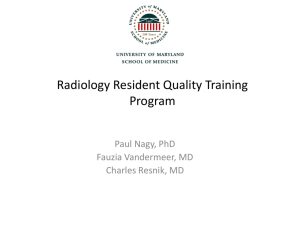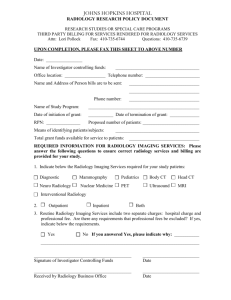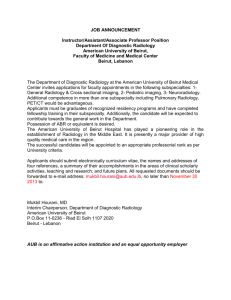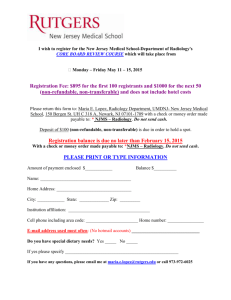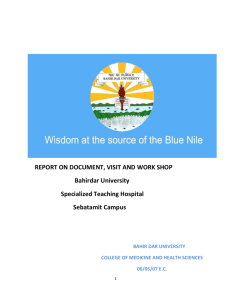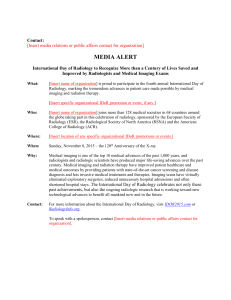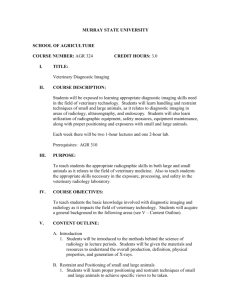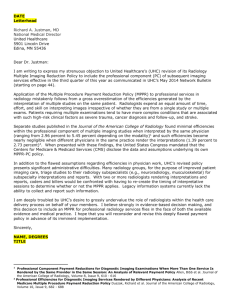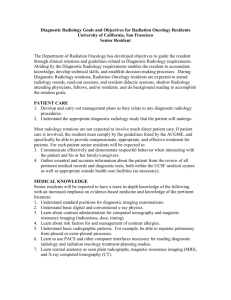Diagnostic Radiology
advertisement
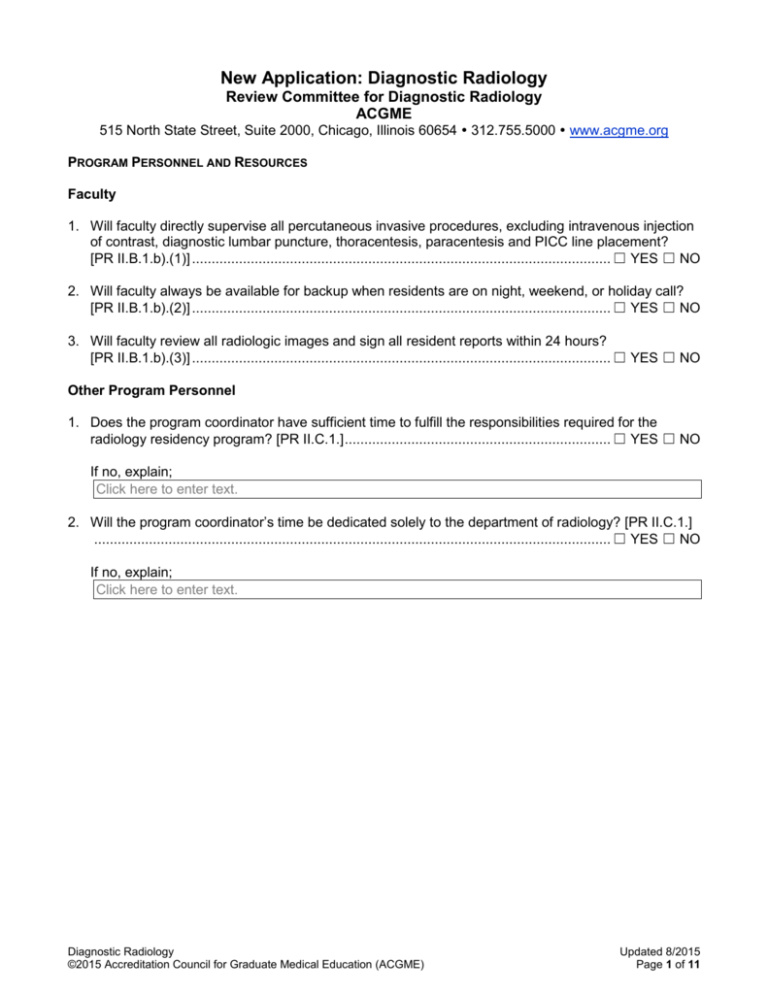
New Application: Diagnostic Radiology Review Committee for Diagnostic Radiology ACGME 515 North State Street, Suite 2000, Chicago, Illinois 60654 312.755.5000 www.acgme.org PROGRAM PERSONNEL AND RESOURCES Faculty 1. Will faculty directly supervise all percutaneous invasive procedures, excluding intravenous injection of contrast, diagnostic lumbar puncture, thoracentesis, paracentesis and PICC line placement? [PR II.B.1.b).(1)] ........................................................................................................... ☐ YES ☐ NO 2. Will faculty always be available for backup when residents are on night, weekend, or holiday call? [PR II.B.1.b).(2)] ........................................................................................................... ☐ YES ☐ NO 3. Will faculty review all radiologic images and sign all resident reports within 24 hours? [PR II.B.1.b).(3)] ........................................................................................................... ☐ YES ☐ NO Other Program Personnel 1. Does the program coordinator have sufficient time to fulfill the responsibilities required for the radiology residency program? [PR II.C.1.] .................................................................... ☐ YES ☐ NO If no, explain; Click here to enter text. 2. Will the program coordinator’s time be dedicated solely to the department of radiology? [PR II.C.1.] .................................................................................................................................... ☐ YES ☐ NO If no, explain; Click here to enter text. Diagnostic Radiology ©2015 Accreditation Council for Graduate Medical Education (ACGME) Updated 8/2015 Page 1 of 11 Resources 1. Equipment [PR II.D.1.] Indicate, for each site, the number of units available and year of most recent installation. Primary Clinical Site (hospital) #1 Site #2 Site #3 Site #4 Site #5 Year of most Year of most Year of most Year of most Year of most # of recent # of recent # of recent # of recent # of recent Equipment Units installation Units installation Units installation Units installation Units installation Radiographic units # Year # Year # Year # Year # Year (include chest units) Fluoroscopic units # Year # Year # Year # Year # Year Mammography # Year # Year # Year # Year # Year Units CT Units # Year # Year # Year # Year # Year Fewer than 16 # Year # Year # Year # Year # Year detector rows 16 or 32 # Year # Year # Year # Year # Year detector rows 64 or more # Year # Year # Year # Year # Year detector rows Ultrasound # Year # Year # Year # Year # Year Units MRI Units # Year # Year # Year # Year # Year Less than # Year # Year # Year # Year # Year 1.5 T 1.5 T # Year # Year # Year # Year # Year 3.0 T # Year # Year # Year # Year # Year SPECT # Year # Year # Year # Year # Year SPECT/CT # Year # Year # Year # Year # Year PET # Year # Year # Year # Year # Year PET/CT # Year # Year # Year # Year # Year Diagnostic Radiology ©2015 Accreditation Council for Graduate Medical Education (ACGME) Updated 8/2015 Page 2 of 11 Primary Clinical Site (hospital) #1 Site #2 Site #3 Site #4 Site #5 Year of most Year of most Year of most Year of most Year of most # of recent # of recent # of recent # of recent # of recent Equipment Units installation Units installation Units installation Units installation Units installation Single plane Angio # Year # Year # Year # Year # Year Suite Bi-plane Angio # Year # Year # Year # Year # Year Suite 2. Information Technology Systems [PR II.D.1.] RIS / PACS Is there a RIS (Radiology Information System)? Is there PACS (Picture Archiving Communication System)? Primary Clinical Site (hospital) #1 Site #2 Site #3 Site #4 Site #5 Year of most Year of most Year of most Year of most Year of most Check recent Check recent Check recent Check recent Check recent if Yes installation if Yes installation if Yes installation if Yes installation if Yes installation Year Year Year Year Year ☐ ☐ ☐ ☐ ☐ ☐ Year ☐ Year ☐ Year ☐ Year ☐ Year 3. Space Allocation [PR II.D.1.] Indicate whether available at each site Primary Clinical Allocation of Space Site #1 Dedicated radiology ☐ YES ☐ NO conference room Dedicated radiology ☐ YES ☐ NO call room Dedicated resident ☐ YES ☐ NO offices/lounges Site #2 Site #3 Site #4 Site #5 ☐ YES ☐ NO ☐ N/A ☐ YES ☐ NO ☐ N/A ☐ YES ☐ NO ☐ N/A ☐ YES ☐ NO ☐ N/A ☐ YES ☐ NO ☐ N/A ☐ YES ☐ NO ☐ N/A ☐ YES ☐ NO ☐ N/A ☐ YES ☐ NO ☐ N/A ☐ YES ☐ NO ☐ N/A ☐ YES ☐ NO ☐ N/A ☐ YES ☐ NO ☐ N/A ☐ YES ☐ NO ☐ N/A Diagnostic Radiology ©2015 Accreditation Council for Graduate Medical Education (ACGME) Updated 8/2015 Page 3 of 11 4. Briefly describe the secure on-site call facilities for residents at locations where in-house call is required [PR II.D.2.] Click here to enter text. 5. Subspecialty Chiefs [PR II.B.2.b) – II.B.2.d).(1)] Subspecialty Abdominal Radiology (GI/GU) Breast Imaging Cardiothoracic Musculoskeletal Nuclear Radiology Neuroradiology Pediatric Radiology Ultrasonography (including OB & vascular ultrasound) Vascular/Interventional Radiology Name of Subspecialty Chief Name Estimated % of time devoted to the subspecialty Qualifications* #% Qualifications Name Name Name Name Name Name Name #% #% #% #% #% #% #% Qualifications Qualifications Qualifications Qualifications Qualifications Qualifications Qualifications Name #% Qualifications *Qualifications: Indicate by number all that apply 1. Current subspecialty certification (CAQ) 2. Fellowship training 3. Three years of subspecialty practice 4. Membership in a subspecialty society 5. Publications and presentations in the subspecialty 6. Annual CME credits in the subspecialty 7. Participation in MOC with emphasis on the subspecialty area 6. Learning Resources a) Is there a teaching file (ACR or equivalent) available to residents? [PR II.D.3.] ...... ☐ YES ☐ NO b) Will the residents have access to a radiology-specific library or electronic reference materials? [PR II.E.]................................................................................................................. ☐ YES ☐ NO 7. Imaging Examinations Performed All information requested must be included for each participating site with the exception of those sites where only a limited sub-specialty rotation is employed as a part of the educational experience. Example: For a cardiovascular rotation, include only the cardiovascular examination data and equipment. Note, however, that total statistics are required for a pediatric rotation. [PR II.D.4. – II.D.4.a)] Period covered by statistics (latest 12 month period available) From: Click here to enter a date. Diagnostic Radiology ©2015 Accreditation Council for Graduate Medical Education (ACGME) To: Click here to enter a date. Updated 8/2015 Page 4 of 11 Number of Exams Radiography Computed tomography Mammography Angiography MRI Ultrasound Nuclear Medicine of CV System Vascular/Interventional Total Exams Primary Clinical Site #1 # # # # # # # # # Site #2 # # # # # # # # # Site #3 # # # # # # # # # Site #4 # # # # # # # # # Site #5 # # # # # # # # # THE EDUCATIONAL PROGRAM Summary of Training 1. Complete the outline provided here to show the typical resident assignments for the four-year program. Provide the information in weeks. Not all categories may be appropriate for all programs. Summary of Training Cardiothoracic Abdominal Imaging(GI/GU) Musculoskeletal Breast Imaging Nuclear radiology Neuroradiology Pediatric radiology Vascular/Interventional radiology Emergency Radiology (if separate) Ultrasound Computed tomography Magnetic resonance imaging Pathology/AFIP Research Elective time (if not included above) Vacation Other (does not fit into above categories; identify and describe) Total (in weeks) Duration of Assignment Year 1 Year 2 Year 3 Year 4 # # # # # # # # # # # # # # # # # # # # # # # # # # # # # # # # # # # # # # # # # # # # # # # # # # # # # # # # # # # # # # # # # # # # # # # Total # # # # # # # # # # # # # # # # # # # 2. Attach representative goals and objectives for one rotation with their corresponding evaluation measurement. Click here to enter text. 3. Will the curriculum outline and statement of goals and objectives be distributed to teaching staff and Diagnostic Radiology ©2015 Accreditation Council for Graduate Medical Education (ACGME) Updated 8/2015 Page 5 of 11 residents? [PR IV.A.1.] ................................................................................................. ☐ YES ☐ NO 4. Will the goals and objectives be reviewed by the resident at the start of each rotation? .................................................................................................................................... ☐ YES ☐ NO 5. Are any of the rotation(s) observational in nature? ....................................................... ☐ YES ☐ NO If yes, provide a rationale; Click here to enter text. Subspecialty Didactic Content 1. Describe at least one outcome measure which will be used to assess your residents’ medical knowledge. Click here to enter text. 2. Is there a core didactic curriculum that repeats at least every two years? [PR IV.A.3.a)] .................................................................................................................................... ☐ YES ☐ NO If yes, does it include the following? a) Coverage of all 9 subspecialty areas? [PR IV.A.3.b).(1).(a)] ................................... ☐ YES ☐ NO b) Anatomy, physiology, disease processes, and imaging in all age groups? [PR IV.A.3.b).(1).(a)]............................................................................................... ☐ YES ☐ NO c) Radiologic physics, instrumentation and radiobiology? [PR IV.A.3.b).(1).(c).(i); IV.A.3.b).(2).(a)] ............................................................................................................................... ☐ YES ☐ NO Where, how much and by whom? Click here to enter text. a) Patient and medical personnel safety (i.e. radiation protection, MRI safety)? [PR IV.A.3.b).(1).(c).(ii).; IV.A.3.b).(2).(b)]............................................................... ☐ YES ☐ NO b) Chemistry of by-product material for medical use? [PR IV.A.3.b).(1).(c).(iii)] .......... ☐ YES ☐ NO c) Biologic and pharmacological actions of materials administered in diagnostic and therapeutic procedures? [PR IV.A.3.b).(1).(c).(iv)] ....................................... …………………….☐ YES ☐ NO d) Topics in safe handling, administration, and quality control of radionuclide doses in clinical medicine? [PR IV.A.3.b).(1).(c).(v)]......................................................................... ☐ YES ☐ NO e) Ordering, receiving, and unpacking radioactive material safely and performing the related radiation surveys? [PR IV.A.3.b).(1).(d)] ................................................................. ☐ YES ☐ NO f) The safe elution and quality control of radionuclide generator systems? [PR IV.A.3.b).(1).(d)]............................................................................................... ☐ YES ☐ NO Diagnostic Radiology ©2015 Accreditation Council for Graduate Medical Education (ACGME) Updated 8/2015 Page 6 of 11 g) Calculating, measuring and safely preparing patient doses? [PR IV.A.3.b).(1).(d)] ............................................................................................................................... ☐ YES ☐ NO h) Calibration and quality control of survey meters and dose calibrators? [PR IV.A.3.b).(1).(d)] ............................................................................................................................... ☐ YES ☐ NO i) Safe handling and administration of therapeutic doses of unsealed radionuclide sources? [PR IV.A.3.b).(1).(d)]............................................................................................... ☐ YES ☐ NO j) Written directives? [PR IV.A.3.b).(1).(d)]................................................................. ☐ YES ☐ NO k) Response to radiation spills and accidents? [PR IV.A.3.b).(1).(d)] .......................... ☐ YES ☐ NO l) Radiation signage and related materials? [PR IV.A.3.b).(1).(d)] ............................. ☐ YES ☐ NO a) Using administrative controls to prevent medical events involving the use of unsealed byproduct material? [PR IV.A.3.b).(1).(d)] ............................................................................... ☐ YES ☐ NO b) Appropriate imaging utilization? [PR IV.A.3.b).(2).(c)]............................................. ☐ YES ☐ NO c) Instruction in radiologic-pathologic correlation? [PR IV.A.3.b).(2).(d)] ..................... ☐ YES ☐ NO If yes, describe. Click here to enter text. a) Fundamentals of molecular imaging? [PR IV.A.3.b).(2).(e)] .................................... ☐ YES ☐ NO b) Biological and pharmacologic actions of materials administered in diagnostic or therapeutic procedures? [PR IV.A.3.b).(2).(f)] ........................................................................... ☐ YES ☐ NO c) Use of devices employed in invasive image-based diagnostic and therapeutic procedures? [PR IV.A.3.b).(2).(g)] ..................................................................................................... ☐ YES ☐ NO d) Socioeconomics of radiologic practice? [PR IV.A.3.b).(2).(h)]................................. ☐ YES ☐ NO e) Professionalism and ethics? [PR IV.A.3.b).(2).(i)] ................................................... ☐ YES ☐ NO 3. Provide a representative monthly schedule of conferences. [PR IV.A.3.b).(1)] Click here to enter text. 4. What percentage of all scheduled conferences will be presented by residents, without faculty assistance? [PR II.A.4.u)] Click here to enter text. Patient Care 1. How often will the procedure log be reviewed by the program director or faculty designee and submitted to the ACGME? [PR II.A.4.p).(1)] Diagnostic Radiology ©2015 Accreditation Council for Graduate Medical Education (ACGME) Updated 8/2015 Page 7 of 11 Click here to enter text. 2. List at least one outcome measure which will be used to assess your residents’ delivery of safe, efficient, appropriately utilized, quality-controlled diagnostic and/or interventional radiology techniques. [PR IV.A.5.a).(1).(a)] Click here to enter text. 3. For the areas listed in the table below, identify the learning activities in which the residents (engage to ensure that they understand the principles, indications, contraindications, risks and interpretation of results. [PR IV.A.5.a).(2).(a)-(e)] CORE CURRICULUM Procedures I-131 therapies <33 millicuries I-131 therapies >33 millicuries Mammograms Image-guided biopsies Drainage procedures Angioplasty Embolization and infusion procedures Other percutaneous interventional procedures Conventional radiography Computed tomography Magnetic resonance imaging Angiography Nuclear radiology examinations of the CV system BLS List in Bulleted Format the Learning Activities and Settings Used to Address the List in Bulleted Format the Core Knowledge Areas for Method(s) Used to Evaluate Patient Care and Procedures Fellow Competency* Click here to enter text. Click here to enter text. Click here to enter text. Click here to enter text. Click here to enter text. Click here to enter text. Click here to enter text. Click here to enter text. Click here to enter text. Click here to enter text. Click here to enter text. Click here to enter text. Click here to enter text. Click here to enter text. Click here to enter text. Click here to enter text. Click here to enter text. Click here to enter text. Click here to enter text. Click here to enter text. Click here to enter text. Click here to enter text. Click here to enter text. Click here to enter text. Click here to enter text. Click here to enter text. Click here to enter text. Click here to enter text. 4. Will each resident participate in at least 3 low dose therapies involving oral administration of I-131 and at least 3 high dose therapies involving oral administration of I-131? [PR IV.A.5.a).(2).(a)] .................................................................................................................................... ☐ YES ☐ NO a) Will this include participation in patient selection, informed consent, understanding and calculating the administered dose, counseling of patients and their families on radiation safety issues and patient follow up? [PR IV.A.5.a).(2).(a).(i)] ............................................ ☐ YES ☐ NO 5. Will each resident have documentation of at least 240 mammograms within a 6 month period during their last 2 years of the residency? [PR IV.A.5.a).(2).(b)] .............................................. ☐ YES ☐ NO 6. How will residents obtain clinical training and experience in cardiac imaging? [PR IV.A.5.a).(2).(d)] Diagnostic Radiology ©2015 Accreditation Council for Graduate Medical Education (ACGME) Updated 8/2015 Page 8 of 11 Click here to enter text. 7. Will all residents have current basic life-support (BLS) certification? [PR IV.A.5.a).(2).(e)] .................................................................................................................................... ☐ YES ☐ NO 8. Will each resident competently perform a minimum of 12 months of training in diagnostic radiology prior to independent in-house on-call responsibilities? [PR IV.A.5.a).(2).(f)] ................. ☐ YES ☐ NO 9. Will residents have a minimum of 700 hours of training and experience in clinical nuclear medicine? [PR IV.A.6.b)] ............................................................................................................... ☐ YES ☐ NO a) Will this include 80 hours of classroom and laboratory instruction? [PR IV.A.6.b)] .. ☐ YES ☐ NO If no, explain. Click here to enter text. 10. Will each resident have a minimum of 12 weeks of clinical rotations in breast imaging? [PR IV.A.6.c)] ...................................................................................................................... ☐ YES ☐ NO 11. Will the residents be required to keep a log that documents their participation in I-131 therapies; interpretation/multi-reading of mammograms; and, the performance, interpretation, and complications of vascular, interventional and invasive procedures? [PR V.A.1.b).(6).(c).(i).(a).(i)-(iv)] .................................................................................................................................... ☐ YES ☐ NO Practice-based Learning and Improvement For the areas listed in the table below identify the learning activities in which residents engage to ensure that they understand these concepts. [PR IV.A.5.c).(9)-(11)] CORE CURRICULUM Personal practice evaluation for practice improvement Access, interpret and apply best scientific evidence to the care of patients Radiation exposure, protection, and safety awareness and application List in Bulleted Format the Learning Activities and Settings Used to Address the Core Knowledge Area Click here to enter text. List in Bulleted Format the Method(s) Used to Evaluate Fellow Competency* Click here to enter text. Click here to enter text. Click here to enter text. Click here to enter text. Click here to enter text. Interpersonal Communication Skills For the areas listed in the table below identify the learning activities in which residents engage to ensure that they understand these skills. [PR IV.A.5.d).(6)-(7)] Diagnostic Radiology ©2015 Accreditation Council for Graduate Medical Education (ACGME) Updated 8/2015 Page 9 of 11 List in Bulleted Format the Learning Activities and Settings Used to Address the Core Knowledge Area Click here to enter text. CORE CURRICULUM Communication with patients, colleagues, referring physicians, and other members of the health care team Supervise or act as consultants to and teach medical students and residents Click here to enter text. List in Bulleted Format the Method(s) Used to Evaluate Fellow Competency* Click here to enter text. Click here to enter text. Systems-based Practice For the areas listed in the table below identify the learning activities in which residents engage to ensure that they understand these skills. [PR IV.A.5.f).(7)-(8)] CORE CURRICULUM Understanding of the local and national healthcare system Identification of existing systems problems Systematic analysis of systems problems; including solution development, implementation and evaluation List in Bulleted Format the Learning Activities and Settings Used to Address the Core Knowledge Area Click here to enter text. List in Bulleted Format the Method(s) Used to Evaluate Fellow Competency* Click here to enter text. Click here to enter text. Click here to enter text. Click here to enter text. Click here to enter text. *Examples of evaluation methods for competence may include: direct observation, global assessment, multisource assessment, practice/billing audit, patient survey, record/chart review, review of patient outcomes, simulations/models, structured case discussion, in-house written examination, In-training examination, oral examination and computer-based learning. Resident Scholarly Activities 1. Describe support for resident research and scholarly activity. [PR IV.B.3.] Click here to enter text. 2. Describe how you provide training in critical thinking skills and research design. [PR IV.B.2.a)] Click here to enter text. 3. Describe how resident scholarly projects will be evaluated [PR IV.B.2.b).(3)] Click here to enter text. RESIDENT EVALUATION Will the Resident Learning Portfolios contain documentation of the following items? [PR V.A.1.b).(6).(c). - (c).(vii)] Diagnostic Radiology ©2015 Accreditation Council for Graduate Medical Education (ACGME) Updated 8/2015 Page 10 of 11 1. Case/procedure logs .................................................................................................... ☐ YES ☐ NO 2. Conferences, courses/meetings attended .................................................................... ☐ YES ☐ NO 3. Self-assessment modules completed ........................................................................... ☐ YES ☐ NO 4. Compliance of nuclear medicine and breast imaging regulatory-based training requirements .................................................................................................................................... ☐ YES ☐ NO 5. Performance on yearly objective examinations ............................................................ ☐ YES ☐ NO 6. Reflective process evidenced by individual learning plans and self-assessment .......... ☐ YES ☐ NO 7. Formal assessment of oral and written communication ................................................ ☐ YES ☐ NO 8. Compliance with institutional and departmental policies ............................................... ☐ YES ☐ NO 9. Status of medical licensure, if appropriate .................................................................... ☐ YES ☐ NO 10. Learning activity that involves deriving a solution to a system problem ........................ ☐ YES ☐ NO 11. Scholarly activity .......................................................................................................... ☐ YES ☐ NO Diagnostic Radiology ©2015 Accreditation Council for Graduate Medical Education (ACGME) Updated 8/2015 Page 11 of 11
